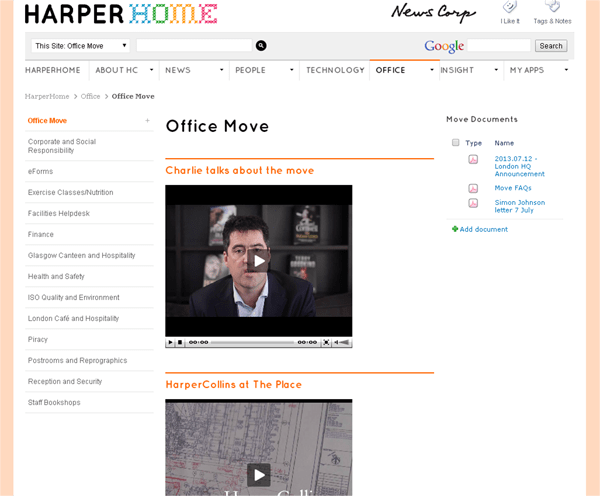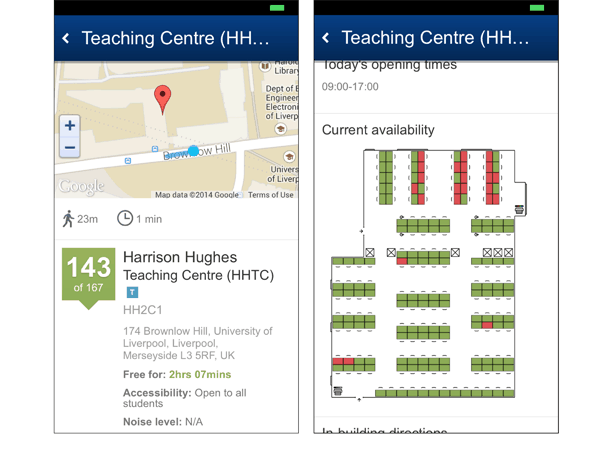
Information sign at airport from Shutterstock.
Filed under: Digital workplace, Intranet and digital workplace awards, Intranets, Latest Features
New ways of working within the office environment means that employees are less likely to be based at one single location, and may work in multiple parts of the building. This is driven by the rise of activity-based working where employees have no fixed desk, and might need to book their desk in advance.
Many physical workplaces are also huge sprawling places, spread over different different locations or multiple buildings. In these cases, like a university campus, it can be confusing finding your way around.
Intranets have always contained information and supported transactions relating to facilities in the physical workplace, such as displaying the restaurant menu or allowing the booking of meeting rooms.
Leading edge intranets now go one step further, and act as guides to the physical workplace, helping employees to navigate round the office, frequently in real time.
The opportunity for intranets
Activity-based working and workplaces with multiple buildings provides an opportunity for intranets to add value by helping employees to navigate through a building they are either unfamiliar.
Here are just some of the ways intranets can help:
- show the location of different facilities, such as specific meeting rooms
- show the location of where people are sitting either in fixed desks or at a given time
- show where there are free desks in order to find a place to work
- distribute information about a new physical location
- allow users to book different desks or facilities
This sort of information can be delivered more effectively and with greater impact by:
- providing floor plans
- using personalisation to display information on a particular location
- integrating with systems which give information about facilities, such as booking meeting room systems
- creating applications for mobile devices which utilise GPS data which show where people are at a given moment
Entries from the recent Intranet Innovation Awards show how intranets are providing a guide to the physical office. A few of these examples are described below.
Informing employees about their new office at HarperCollins UK

The Office Move section of the HarperCollins UK intranet informed employees about a major office move. Screenshot appears courtesy of HarperCollins UK.
HarperCollins UK is a book publisher employing around 1,000 people. The company used its intranet HarperHome as the main change management channel to let 450 employees know about an office move into a new London-based headquarters.
A special “Office Move” section of the intranet let employees know about the new building, answered FAQs, gave status updates and timetable information and also featured videos from the CEO and other staff. The intranet not only informed users and managed expectations, but also engaged employees about the exciting move.
Locating employees in real time at Klick Health

On the Klick Health intranet information about where a person sits is embedded in their profile. Screenshot appears courtesy of Klick Health.

A separate “Locator” tool is also available which shows where a person sits superimposed on the floorplan. It also displays whether they are in the office and what floor they are currently on. Screenshot appears courtesy of Klick Health.
Klick Health is a digital agency based in Canada which primarily serves the healthcare industry. The company’s intranet Genome has employee profiles which are integrated with the floor plans of the company’s four-story office. This allows users to find where other employees are located, a feature which has proved useful as the company expands and also because project teams are often dynamic.
The employee search facility on Genome also gives real time information on an employee’s location. Systems integration means that the intranet can let people know if an individual is on vacation and travelling. Also when employees move between floors of the office they swipe in and out using their security pass. This information is integrated with an intranet search facility to reveal in real time which floor an employees is on or if they have left the building.
Locating spare PCs at the University of Liverpool

The University of Liverpool’s PC Finder app locates the nearest facility with a spare PC on a smartphone (left). Students can drill down to see the actual location of the terminal. (Right). Screenshots appear courtesy of the University of Liverpool.
The University of Liverpool uses a mobile app to allow students to locate spare PCs on campus which they can use for their studies. This can be critical for students, particularly near exam time. Using GPS capability on the smartphone, students can display in real time the nearest spare PC to them which is currently free to use.
Additional information about the distance to the building, opening times, working conditions and the actual location of the spare terminal are also displayed. Many students were unaware that they could use PCs in any of the multiple campus buildings, not just the ones in their faculty. It has also helped maintain student satisfaction with digital services. For companies undertaking activity-based working a similar approach to finding spare desks could prove invaluable.
Knowing where students are at Lakewood Schools

The Hall Pass System at Lakewood High School shows all students who have been given permission to move through the corridor. Image appears courtesy of Lakewood High School.
Lakewood High School is based in Florida, USA. Unusually the high school has a sophisticated SharePoint platform which is administered by the students themselves, an innovation which helped the school to win the 2014 Platinum Award at the Intranet Innovation Awards.
One of the apps available on the intranet is the Hall Pass system. This helps to control the flow of students through the school as they go to the bathroom or move through the corridor. This ensures the safety of students, enforces discipline and allows for the smooth running of a very busy high school. After gaining permission to leave a classroom, students scan their security passes and their movement is logged on the intranet. Monitors in the corridors can then check who has permission to move around the school via their tablet or laptop.
Find out more
For more insights, the Intranet Innovations 2014 report features 17 in-depth case studies and over 200 screenshots. This is the must-have report for intranet teams to guide their planning, and it represents incredible value.
And of course, if your’re using your intranet to guide employees around your physical workplace in an unusual way then you should enter the 2015 Intranet Innovation Awards. We open for entries next week on April 21!




